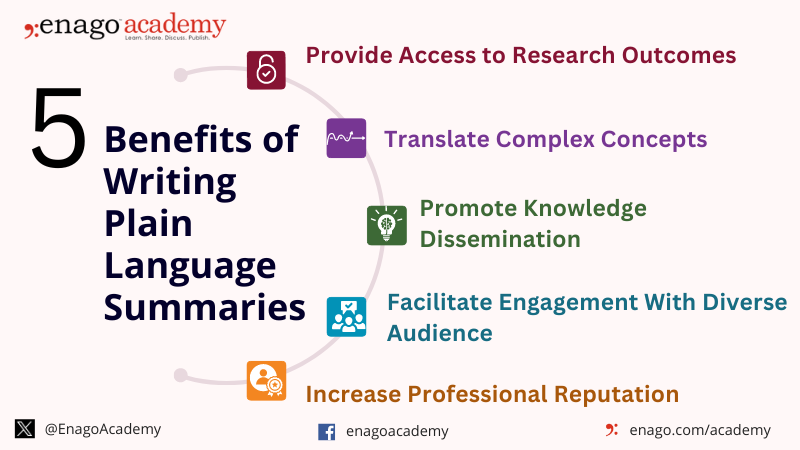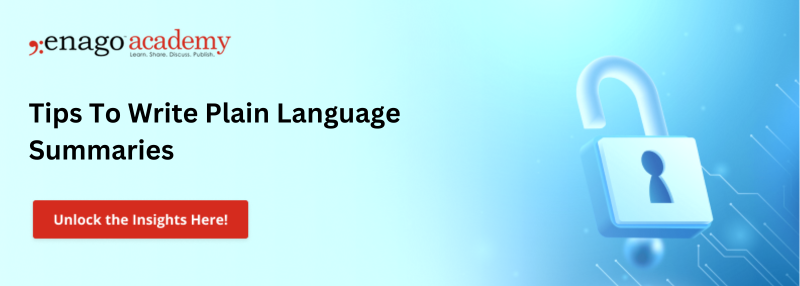Plain Language Summary — Communicating your research to bridge the academic-lay gap

Science can be complex, but does that mean it should not be accessible to the general public? Scientific jargons often hinder the everyday understanding of research. For researchers, the ability to communicate their findings effectively is paramount for career progression. Researchers often wonder how to transform complex concepts into engaging narratives. A similar problem was encountered by Dr. Keating, a post-doctoral cancer researcher. Communicating her research findings to the lay-public had always been her ultimate motive. However, in the fast-paced world of academia and research, where complexity often reigns supreme, she wondered ways to bridge the gap between academia and the lay public.
As she explored solutions that serve this purpose, she came across Plain Language Summaries. While the term might sound simple, its implications are profound, especially in fields like healthcare, where simplified communication can improve the public understanding.
What Is a Plain Language Summary
Plain Language Summaries or Lay Summaries, as the name suggests, are concise and accessible summaries of research findings. Crafted in simple language, it promotes easy comprehension of a research to the layman. Unlike traditional abstracts, which cater primarily to academic peers, lay summaries aim to make research understandable and relevant to non-experts. As she read, Dr. Keating wondered, ‘What are the benefits of writing a plain language summary?’ Here’s what she found:

Beyond the confines of academic circles, the impact of research is often measured by its ability to bring changes in society. Dr. Keating was convinced by its ability in amplifying the reach and impact of her research, thereby bolstering her professional reputation and influence.
Furthermore, in healthcare, where research directly impacts patient outcomes, the importance of effective communication cannot be overstated. Additionally, several publishers encourage the creating lay summaries to enhance public engagement with research. By distilling complex medical jargon into plain, understandable language, lay summaries empower individuals to make informed decisions about their health and treatment options.
However, she was confused of the difference between plain language summaries and abstracts. She decided to continue her read to know more.
Difference Between Plain Language Summary and Abstract
Plain Language Summary |
Abstract |
| Provides a simple overview of a research study | Provides field-specific details of the study |
| Fewer jargon and technical terminology | Often laden with technical terminology |
| Caters a broader demographic | Caters academic audience |
| Simplifies discipline-specific terms or concepts | Does not simplify discipline-specific terms or concepts |
While abstracts focus on conveying the crux of the research, Plain Language Summaries prioritize clarity and accessibility. Different types of plain language summaries cater this purpose.
Different Types and Structure of Plain Language Summaries
Plain Language Summaries can take various forms, including executive summaries, lay summaries, and policy briefs, each tailored to suit the needs of different audiences. Each type serves a unique purpose, catering to different audience preferences and accessibility needs.
Sign Up For More InsightsGenerally, a lay summary follows a structured format, encompassing key elements such as the research question, methodology, findings, and implications in simple, straightforward language.
How To Write a Plain Language Summary
Before Dr. Keating began writing the plain language summary, she decided to refer to an infographic guide on effective tips to write a summary. Curious to know what she referred?
 Writing a compelling Plain Language Summary requires careful consideration and attention to detail. Additionally, it is essential to highlight the relevance and real-world implications of the research findings, ensuring that the summary resonates with the target audience.
Writing a compelling Plain Language Summary requires careful consideration and attention to detail. Additionally, it is essential to highlight the relevance and real-world implications of the research findings, ensuring that the summary resonates with the target audience.
Dr. Keating invested her time and effort into crafting a comprehensive summary which significantly expanded the reach and impact of her research. Moreover, it attracted attention and appreciation from diverse audiences by increasing the public engagement with her research.
Example of a Plain Language Summary
Here’s the plain language summary written by Dr. Keating:
Title: Exploring New Strategies for Cancer Treatment: A breakthrough in immunotherapy
Summary:
In our research, we investigated innovative approaches to treating cancer, focusing on a groundbreaking method called immunotherapy. Cancer is a complex disease where abnormal cells grow uncontrollably, posing a significant health challenge worldwide. Traditional treatments like chemotherapy and radiation therapy often have harsh side effects and may not always effectively eradicate cancer cells.
Immunotherapy offers a promising alternative by harnessing the body’s own immune system to target and destroy cancer cells. In our study, we explored how a specific type of immunotherapy, known as checkpoint inhibitors, works to unleash the immune system’s full potential against cancer. By blocking certain proteins that inhibit immune response, checkpoint inhibitors help immune cells recognize and attack cancer cells more effectively.
Through experiments conducted on cancer cell cultures and animal models, we demonstrated the effectiveness of checkpoint inhibitors in shrinking tumors and improving overall survival rates. Furthermore, our research uncovered potential biomarkers that could help identify patients who are most likely to benefit from this treatment, paving the way for personalized cancer therapies.
Our findings represent a significant advancement in cancer treatment, offering hope for improved outcomes and quality of life for patients. Immunotherapy has the potential to revolutionize cancer care by providing more targeted and less toxic treatment options. However, further clinical trials and research are needed to fully realize the potential of immunotherapy. This can help in combating various types of cancer and improving patient outcomes.
*The above summary is hypothetical and has been written solely for illustrative purposes, demonstrating an example of a plain language research summary.
Harnessing the Power of Blogging Platforms
In the digital age, blogging platforms like Enago Academy’s Open Platform offer researchers a unique opportunity to share their research with a global audience. By leveraging these platforms, researchers can reach beyond the confines of academia and engage with diverse communities, fostering dialogue and collaboration.
By distilling complex concepts into simple narratives, knowledge dissemination can be promoted beyond the scientific community. It not only represented a transformative approach in science but also drives a positive change and innovation in healthcare and beyond.
Frequently Asked Questions
A plain language summary can be around 300 words.
The value of a plain language summary lies in its ability to make complex information more accessible and understandable to a wider audience. Furthermore, readers can quickly get the gist of a document without having to wade through pages of dense text. It also improves the communication gap between experts and non-experts.
Plain language summaries are concise, easy-to-understand versions of longer, more complex documents or pieces of information. They are written in clear, simple language, avoiding technical jargon and complex terminology. The goal of a plain language summary is to make information accessible to a broader audience, including those with varying levels of literacy or expertise in a particular subject.
Plain language summaries are typically written by professionals or experts in a particular field who have a deep understanding of the subject matter. They are written by researchers/ scientists, healthcare professionals, government agencies, nonprofit organizations, journalists/communicators, legal professionals, educators, technical writers, etc.












